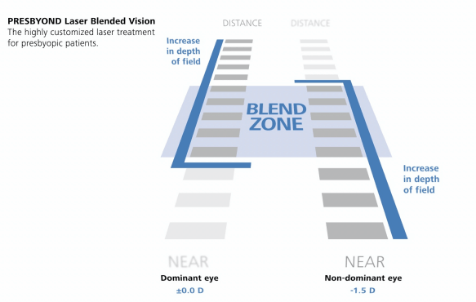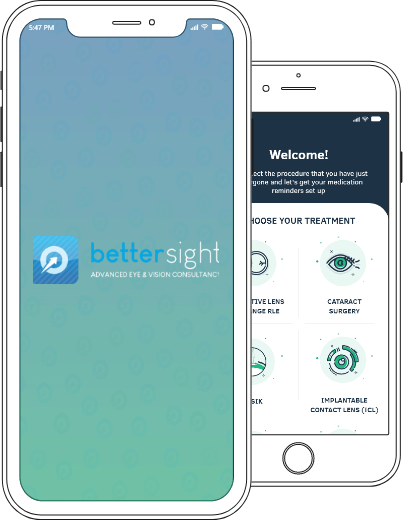

Let us help you get beyond Presbyopia with Presbyond (TM)
or you can download my guide to State of the art vision correction treatments

There are lots of positive things about getting into your forties and early fifties. For one thing, many people report an overall general sense of satisfaction in their lives. You may have achieved many of the goals you set in your youth. You may well feel – well more in control of your life and that is great.
However, time waits for no one, and slowly, silently a condition called Presbyopia starts creeping into your life from your early to mid-forties onwards. In short your eyes begin to ‘feel old’ and you may if your short sighted find yourself taking your glasses off to focus on near range tasks such as reading documents or even the computer screen. Alternatively if you previously enjoyed good distance vision even without glasses, you may find yourself holding things further away to help with the focus, or you might start having to have a few reading glasses dotted around the house!
The simple reason for all these problems is down to a declining flexibility of the natural human lens- sometimes called the crystalline lens. Loss of flexibility in fact starts quite early in life, but nature has endowed us with a high degree of reserve flexing power in the crystalline lens.
As we get into the fifth and sixth decades of our lives, the reserve power of the crystalline lens is depleted to a point where the symptoms of presbyopia start developing as described above.
Now, this wouldn't be so bad if only you had telescopic arms!

In the simplest terms, PresbyondTM is a advanced form of mono-vision treatment. Mono-vision itself works when one eye is ‘set’ for distance viewing and the other eye is set for ‘close’ viewing. Remember, the brain is the ultimate seeing organ and for many people the brain can blend the information together in such a way as to generate useful distance vision AND close vision.
Mono-vision can indeed work well for a large proportion of people, in fact around two thirds of the general population can work with mono-vision quite well.
There are however some drawbacks of mono-vision, they are:

PresbyondTM is an advanced form of mono-vision. Although one eyes focus is set for distance and the other eyes focus is still set for closer range, there is an additional modulation of an optical phenomenon called ‘spherical aberration’. It is possible to adjust and augment the amount of spherical aberration present in each eyes’ focusing power in a non-linear way that helps us to achieve two really important attributes:
If this sounds confusing – don’t be. Here is a diagram that shows how the depth of field can be adjusted and in a personalised way so that vision performance is optimised for both far and close range.
The net effect of this advanced approach to presbyopic laser vision correction is that people report the following:
So, in a nutshell – PresbyondTM is a very significant step forwards in treating presbyopia with a Laser vision correction approach.
Despite a severe retinal tear in danger of imminent detachment, macular problems and very poor sight, 34 year old Ashar Saleem not only... Read more
Monovision is where one eye is set for far distance and the other eye is set for vision at a closer focal point. The major difference with Presbyond is that it is Monovision plus. The ‘plus’ refers to the ability to add or remove a specific optical parameter called spherical aberration. By adding or removing small degrees of spherical aberration from the visual system it is possible to increase something called depth of field. This means that the far sighted eye in a monovision set up will allow better vision at intermediate range and the close vision sighted eye will also level up to produce better intermediate range vision – effectively a ‘blend zone’ in the visual system is created by the approach. This additional blend zone adds to improved comfort, tolerance and enhanced depth perception to the underlying monovision state.
We find that presbyond works well for people are able to show natural tolerance to monovision – something which we can test for in our assessment. For people between the ages of 45-55 Presbyond is an excellent means of reducing reliance on ‘reading glasses’ as whilst also correcting distance vision using Laser eye surgery, avoiding intra-ocular surgery.
If you do not show tolerance to monovision then it is unlikely for presbyond to be a potential solution for your situation. Also people with very large prescriptions which are outside the normal range of treatment for Laser vision correction would not be able to benefit from Presbyond either. Such people could consider either ICL or RLE.
No – at present Presbyond is specifically designed to be delivered with an excimer laser – which means LASIK or LASEK/PRK are the techniques that can be used to deliver the Presbyond profile. It is however still possible for you to have a monovision set up with SMILE should you prefer the biological advantages of SMILE to be the over-riding factor in your decision making process.
In general, the close range vision improvement should last up to a decade or so. The far vision improvement should last even longer or until such time you develop a Cataract in later life.
YES – it is often possible to ‘tweak’ the result after a few years, especially if your near vision becomes weaker. This can be done via a ‘flap lift’ technique if you had LASIK Presbyond or by repeat application of LASEK if you had LASEK presbyond.
Cataract surgery is just as safe after you have had Laser vision correction with or without Presbyond. The advantage is that it would be possible for you to retain much of the benefit of Presbyond even after Cataract surgery with careful lens implant power calculations to deliver a far sighted dominant eye and a closer range sighted near dominant eye.
No treatment – indeed no human activity is without some risk. In general, the risks of Presbyond are essentially procedure specific – i.e LASIK risks are slightly different to LASEK risks. Please refer to the relevant sections in this website, but these will always be discussed with you in our virtual consults as well the physical consultations and detailed reference literature will also be provided for you to study before you commit to any treatment with us.
This will depend on whether you had LASIK presbyond or LASEK presbyond and also on whether you were initially short sighted or long sighted. In general however most people report gradual adaptation and improvement in vision performance, comfort and tolerance developing over a 3 month time frame. Much of the improvement however tends to occur early on – especially so if you have LASIK Presbyond.
One of the advantages of a laser based approach to managing presbyopia, is that your natural lens is still in place. This means that there is an element of reversibility in built in Presbyond. For people who are not showing adaptation and who continue to report difficulties in getting used to Presbyond – it is always possible to have the near dominant eye re-corrected into a distance dominant eye – so that both eyes are working at the same focal plane. This would obviously mean that unaided near vision would revert to what it would be like in someone of your age in the natural state. More often however we find that minor ‘tweaks’ in the Presbyond set up can sometimes be very effective in improving overall vision performance and so full reversal is unlikely to be required.
Yes – we do recommend a light sedative – typically a low dose of Diazepam, similar to what many nervous flyers will take before airplane journey. The effect of this is to help you feel more relaxed prior to the procedure. You are still awake and in control but you will feel more ‘chilled’ about the process. You don’t have to have this but it is something we like to offer.
Some eye movement is perfectly manageable, you do not have to be staring in one precise position throughout the procedure! For LASIK and LASEK the excimer laser has a built-in high speed eye tracking device which will track your eye and deliver the treatment exactly where it is programmed.
You don’t have to! A simple device is used to keep your eye open so you don’t have to. You will still be able to blink naturally – but only the ‘other’ eye will actually blink, the eye under treatment will not close once the speculum is in place.
We always advise our patients to go home, take a nap for an hour or two as your eyes may feel a little ‘stingy’ in the first few hours post op. Use the eye goggles for sleeping in for up to a week, do not get water in your eye for around a week, refrain from vigorous sports for at least a week and try not to rub your eyes – especially after LASIK or LASEK. Do remember to use the prescribed eye-drops – you can set reminders using our ‘bettersight’ app to help with this.
Most people are able to see some difference within a few hours after LASIK Presbyond I find most patients are around the 80-90% of their full recovery within 48 hours with the remaining 10-20% vision potential developing over the subsequent 2-4 weeks. For patients who have LASIK for hyperopia – this process may be lengthened a little, and those undergoing LASEK will also find a slower upwards vision trajectory over several weeks. Comfort and tolerance to the underlying monovision set up will sometimes take a little longer and can continue to develop for 3 months or more.
In general, the upper limit for myopia treatment with LASIK is circa -10D. For hyperopia, the upper limit is +4D and for astigmatism it is ±4D. At or beyond these levels we would normally ask you to consider ICL – implantable contact lens treatment with a monovision set up or Refractive lens exchange (if above age 45).
EXTREMELY UNLIKELY!! There have been NO reports of blindness arising immediately and simultaneously to both eyes FROM laser vision correction. With well over 50,000,000 treatments worldwide over the last 30 years, we think it’s fair to say the risk of a dreadful complication such as this arising is probably not dissimilar to the risk of being involved in a serious air plane accident.
If the treatment is carried out, then you will achieve a result. No result is only possible if the treatment is aborted early. If the result is not to your satisfaction and so long as there are no contra-indications, an enhancement procedure can be considered in most cases.
If you have had LASEK/PRK it would most likely to repeat LASEK/PRK that is appropriate.
For those who have had LASIK – a flap lift enhancement approach is often most suitable.
Either way our focus is on achieving the best possible result for you and all options will be considered where required. Note – enhancement laser vision correction is generally performed between 4-12 months post op.
Many eye doctors, opticians, surgeons and dentists have had laser vision correction, equally many have not. It all comes down to personal motivation. Many people who require glasses / contacts are comfortable in continuing with this way of life and that is absolutely fine. It’s important for YOU to have the required motivation to consider undergoing any type of vision correction procedure. It is after all a deeply personal choice and if you come to my service I and my team will do our very best to help you get the result you want in the safest way possible.
Total patient support- in the palm of your hand.
